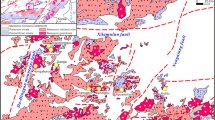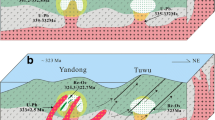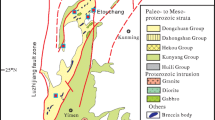Abstract
The Qulong porphyry copper and molybdenum deposit is located at the southwest margin of the Lhasa Terrane and in the eastern region of the Gangdese magmatic belt. It represents China’s largest porphyry copper system, with ∼2200 million tonnes of ore comprising 0.5 % Cu and 0.03 % Mo. The mineralization is associated with Miocene granodiorite, monzogranite and quartz-diorite units, which intruded into Jurassic volcanic units in a post-collisional (Indian-Asian) tectonic setting. Field observations and core logging demonstrate the alteration and mineralization at Qulong are akin to typical porphyry copper systems in subduction settings, which comprise similar magmatic-hydrothermal, potassic, propylitic and phyllic alteration assemblages. Molybdenite Re-Os geochronology confirms the relative timeframe defined by field observations and core logging and indicates that the bulk copper and molybdenum at Qulong were deposited within 350,000 years: between 16.10 ± 0.06 [0.08] (without and with decay constant uncertainty) and 15.88 ± 0.06 [0.08] Ma. This duration for mineralization is in direct contrast to a long-lived intrusive episode associated with mineralization based on previous zircon U-Pb data. Our fluid inclusion study indicates that the ore-forming fluid was oxidized and contained Na, K, Ca, Fe, Cu, Mo, Cl and S. The magmatic-hydrothermal transition occurred at ∼425 °C under lithostatic pressure, while potassic, propylitic and phyllic alteration occurred at hydrostatic pressure with temperature progressively decreasing from 425 to 280 °C. The fluid inclusion data presented here suggests that there has been ∼2.3 km of erosion at Qulong after its formation, and this erosion may be related to regional uplift of the Lhasa Terrane.













Similar content being viewed by others
References
Aitchison JC, Ali JR, Davis AM (2007) When and where did India and Asia collide? J Geophys Res 112:1–19. doi:10.1029/2006jb004706
Ali JR, Aitchison JC (2008) Gondwana to Asia: plate tectonics, paleogeography and the biological connectivity of the Indian sub-continent from the Middle Jurassic through latest Eocene (166–35 Ma). Earth Sci Rev 88:145–166. doi:10.1016/j.earscirev.2008.01.007
Audetat A, Gunther D, Heinrich CA (1998) Formation of a magmatic-hydrothermal ore deposit: insights with LA-ICP-MS analysis of fluid inclusions. Science 279:2091–2094. doi:10.1126/science.279.5359.2091
Azbej T, Severs MJ, Rusk BG, Bodnar RJ (2007) In situ quantitative analysis of individual H2O-CO2 fluid inclusions by laser Raman spectroscopy. Chem Geol 237:255–263. doi:10.1016/j.chemgeo.2006.06.025
Baumgartner M, Bakker RJ, Doppler G (2014) Re-equilibration of natural H2O-CO2-salt-rich fluid inclusions in quartz-Part 1: experiments in pure water at constant pressures and differential pressures at 600 oC. Contrib Mineral Petrol 168:1–14. doi:10.1007/s00410-014-1017-3
Bea F, Montero P, Gonzalez-Lodeiro F, Talavera C (2007) Zircon inheritance reveals exceptionally fast crustal magma generation processes in central iberia during the cambro-ordovician. J Petrol 48:2327–2339. doi:10.1093/petrology/egm061
Bodnar RJ, Vityk MO (1994) Interpretation of microthermometric data for H2O-NaCl fluid inclusions. In: De Vivo B, Frezzotti ML (eds) Fluid inclusions in minerals: Methods and applications. Virginia Tech, Blacksburg, pp 117–130
Bodnar RJ, Lecumberri-Sanchez P, Moncada D, Steele-MacInnis M (2014) 13.5—Fluid inclusions in hydrothermal ore deposits. In: Turekian HDHK (ed) Treatise on Geochemistry, Second Editionth edn. Elsevier, Oxford, pp 119–142
Burke EAJ (2001) Raman microspectrometry of fluid inclusions. Lithos 55:139–158. doi:10.1016/S0024-4937(00)00043-8
Cathles LM, Erendi AHJ, Barrie T (1997) How long can a hydrothermal system be sustained by a single intrusive event? Econ Geol 92:766–771. doi:10.2113/gsecongeo.92.7-8.766
Chang ZS, Meinert LD (2004) The magmatic-hydrothermal transition—evidence from quartz phenocryst textures and endoskarn abundance in Cu-Zn skarns at the Empire Mine, Idaho, USA. Chem Geol 210:149–171. doi:10.1016/j.chemgeo.2004.06.018
Chiaradia M, Schaltegger U, Spikings R, Wotzlaw J-F, Ovtcharova M (2013) How accurately can we date the duration of magmatic-hydrothermal events in porphyry systems?—An invited paper. Econ Geol 108:565–584
Chiaradia M, Schaltegger U, Spikings R (2014) Time scales of mineral systems—advances in understanding over the past decade. Soc Econ Geol Spec p 37–58.
Cooke DR, Hollings P, Walsh JL (2005) Giant porphyry deposits: characteristics, distribution, and tectonic controls. Econ Geol 100:801–818. doi:10.2113/100.5.801
Cooke DR, Hollings P, Wilkinson JJ, Tosdal RM (2014) 13.14—Geochemistry of porphyry deposits. In: Turekian HDHK (ed) Treatise on Geochemistry, Second Editionth edn. Elsevier, Oxford, pp 357–381
Creaser RA, Papanastassiou DA, Wasserburg GJ (1991) Negative thermal ion mass-spectrometry of osmium, rhenium, and iridium. Geochim Cosmochim Acta 55:397–401. doi:10.1016/0016-7037(91)90427-7
Davis DW, Lowenstein TK, Spencer RJ (1990) Melting behavior of fluid inclusions in laboratory-grown halite crystals in the systems NaCl-H2O, NaCl-KCl-H2O, NaCl-MgCl2-H2O, and NaCl-CaCl2-H2O. Geochim Cosmochim Acta 54:591–601. doi:10.1016/0016-7037(90)90355-O
Goldstein RH, Reynolds TJ (1994) Systematics of fluid inclusions in diagenetic minerals. SEPM (Society for Sedimentary Geology), USA
Hou ZQ, Gao YF, Qu XM, Rui ZY, Mo XX (2004) Origin of adakitic intrusives generated during mid-Miocene east–west extension in southern Tibet. Earth Planet Sci Lett 220:139–155. doi:10.1016/S0012-821x(04)00007-X
Hou ZQ, Yang ZM, Qu XM, Meng XJ, Li ZQ, Beaudoin G, Rui ZY, Gao YF, Zaw K (2009) The Miocene Gangdese porphyry copper belt generated during post-collisional extension in the Tibetan Orogen. Ore Geol Rev 36:25–51. doi:10.1016/j.oregeorev.2008.09.006
Hou ZQ, Yang ZM, Lu YJ, Kemp A, Zheng YC, Li QY, Tang JX, Yang ZS, Duan LF (2015) A genetic linkage between subduction- and collision-related porphyry Cu deposits in continental collision zones. Geology 43:247–250. doi:10.1130/G36362.1
Hu YB, Liu JQ, Ling MX, Ding W, Liu Y, Zartman RE, Ma XF, Liu DY, Zhang CC, Sun SJ, Zhang LP, Wu K, Sun WD (2015) The formation of Qulong adakites and their relationship with porphyry copper deposit: Geochemical constraints. Lithos 220:60–80. doi:10.1016/j.lithos.2014.12.025
Landtwing MR, Pettke T, Halter WE, Heinrich CA, Redmond PB, Einaudi MT, Kunze K (2005) Copper deposition during quartz dissolution by cooling magmatic-hydrothermal fluids: the Bingham porphyry. Earth Planet Sci Lett 235:229–243. doi:10.1016/j.epsl.2005.02.046
Lawley CJM, Selby D (2012) Re-Os geochronology of quartz-enclosed ultrafine molybdenite: implications for ore geochronology. Econ Geol 107:1499–1505
Li GM, Rui ZY (2004) Diagenetic and mineralization ages for the porphyry copper deposits in the Gangdise Metallogenic Belt, Southern Xizang. Geotecton Metallog 28:165–170 (In Chinese with English Abstract)
Li GM, Liu B, Qu WJ, Lin FC, Yu HQ, Feng CY (2005) The porphyry- skarn ore- forming system in Gangdese Metallogenic Belt, southern Xizang: Evidence from molybdenite Re-Os age of porphyry- type copper deposits and skarn- type copper polymetallic deposits. Geotecton Metallog 29:482–490 (In Chinese with English Abstract)
Li XH, Liu Y, Li QL, Guo CH, Chamberlain KR (2009) Precise determination of Phanerozoic zircon Pb/Pb age by multicollector SIMS without external standardization. Geochem Geophys Geosyst 10:1–21. doi:10.1029/2009gc002400
Li XH, Li WX, Li QL, Wang XC, Liu Y, Yang YH (2010a) Petrogenesis and tectonic significance of the similar to 850 Ma Gangbian alkaline complex in South China: evidence from in situ zircon U-Pb dating, Hf-O isotopes and whole-rock geochemistry. Lithos 114:1–15. doi:10.1016/j.lithos.2009.07.011
Li XH, Long WG, Li QL, Liu Y, Zheng YF, Yang YH, Chamberlain KR, Wan DF, Guo CH, Wang XC, Tao H (2010b) Penglai zircon megacrysts: a potential new working reference material for microbeam determination of Hf-O isotopes and U-Pb age. Geostand Geoanal Res 34:117–134. doi:10.1111/j.1751-908X.2010.00036.x
Li XH, Tang GQ, Gong B, Yang YH, Hou KJ, Hu ZC, Li QL, Liu Y, Li WX (2013) Qinghu zircon: a working reference for microbeam analysis of U-Pb age and Hf and O isotopes. Chin Sci Bull 58:4647–4654. doi:10.1007/s11434-013-5932-x
Li XH, Liu XM, Liu YS, Su L, Sun WD, Huang HQ, Yi K (2015) Accuracy of LA-ICPMS zircon U-Pb age determination: an inter-laboratory comparison. Sci China Earth Sci 58:1722–1730. doi:10.1007/s11430-015-5110-x
Lindsay DD, Zentilli M, Rivera JRDL (1995) Evolution of an active ductile to brittle shear system controlling mineralization at the chuquicamata porphyry copper deposit, Northern Chile. Int Geol Rev 37:945–958. doi:10.1080/00206819509465434
Ludwig KR (2003) User’s manual for Isoplot 3.00: a geochronological toolkit for Microsoft Excel. Kenneth R. Ludwig.
McPhie J, Kamenetsky V, Allen S, Ehrig K, Agangi A, Bath A (2011) The fluorine link between a supergiant ore deposit and a silicic large igneous province. Geology 39:1003–1006. doi:10.1130/G32205.1
Meng XJ, Hou ZQ, Gao YF, Huang W, Qu XM, Qu WJ (2003) Re-Os dating for molybdenite from Qulong porphyry copper deposit in Gangdese metallogenic Belt, Xizangand its metallogenic significance. Geol Rev 49:660–666 (In Chinese with English Abstract)
Mercer CN, Reed MH, Mercer CM (2015) Time scales of porphyry cu deposit formation: insights from titanium diffusion in quartz. Econ Geol 110:587–602
Qin KZ, Xia DX, Li GM, Xiao B, Duo J, Jiang GW, Zhao JX (2014) Qulong Porphyry-Skarn Cu-Mo Deposit, Tibet. Science Press, Beijing (In Chinese)
Richards JP (2009) Postsubduction porphyry Cu-Au and epithermal Au deposits: products of remelting of subduction-modified lithosphere. Geology 37:247–250. doi:10.1130/G25451a.1
Richards JP (2011) Magmatic to hydrothermal metal fluxes in convergent and collided margins. Ore Geol Rev 40:1–26. doi:10.1016/j.oregeorev.2011.05.006
Richards JP (2013) Giant ore deposits formed by optimal alignments and combinations of geological processes. Nat Geosci 6:911–916. doi:10.1038/NGEO1920
Roedder E (1984) Fluid Inclusions. US Mineralogical Society of America, USA
Rowley DB (1996) Age of initiation of collision between India and Asia: a review of stratigraphic data. Earth Planet Sci Lett 145:1–13. doi:10.1016/S0012-821x(96)00201-4
Rowley DB, Currie BS (2006) Palaeo-altimetry of the late Eocene to Miocene Lunpola basin, central Tibet. Nature 439:677–681. doi:10.1038/nature04506
Rusk BG, Reed MH, Dilles JH (2008) Fluid inclusion evidence for magmatic-hydrothermal fluid evolution in the porphyry copper-molybdenum deposit at Butte, Montana. Econ Geol 103:307–334. doi:10.2113/gsecongeo.103.2.307
Samson I, Anderson A, Marshall D (2003) Fluid inclusions: analysis and interpretation. Mineralogical Association of Canada, Canada
Schaltegger U, Schmitt AK, Horstwood MSA (2015) U-Th-Pb zircon geochronology by ID-TIMS, SIMS, and laser ablation ICP-MS: Recipes, interpretations, and opportunities. Chem Geol 402:89–110. doi:10.1016/j.chemgeo.2015.02.028
Schoene B (2014) 4.10 - U–Th–Pb Geochronology. In: Turekian HDHK (ed) Treatise on Geochemistry, Second Editionth edn. Elsevier, Oxford, pp 341–378
Seedorff E, Dilles J, Proffett J, Einaudi M, Zurcher L, Stavast W, Johnson D, Barton M (2005) Porphyry deposits: characteristics and origin of hypogene features. Econ Geol 29:251–298, 100th Anniversary
Selby D, Creaser RA (2001) Re-Os geochronology and systematics in molybdenite from the Endako porphyry molybdenum deposit, British Columbia, Canada. Econ Geol Bull Soc Econ Geol 96:197–204. doi:10.2113/96.1.197
Selby D, Creaser RA, Stein HJ, Markey RJ, Hannah JL (2007) Assessment of the 187Re decay constant by cross calibration of Re-Os molybdenite and U-Pb zircon chronometers in magmatic ore systems. Geochim Cosmochim Acta 71:1999–2013. doi:10.1016/j.gca.2007.01.008
Sillitoe RH (2010) Porphyry copper systems. Econ Geol 105:3–41
Sillitoe RH, Mortensen JK (2010) Longevity of porphyry copper formation at Quellaveco, Peru. Econ Geol 105:1157–1162. doi:10.2113/econgeo.105.6.1157
Simmons SF, Brown KL (2006) Gold in magmatic hydrothermal solutions and the rapid formation of a giant ore deposit. Science 314:288–291. doi:10.1126/science.1132866
Simmons SF, Brown KL (2007) The flux of gold and related metals through a volcanic arc, Taupo Volcanic Zone, New Zealand. Geology 35:1099–1102. doi:10.1130/G24022a.1
Sláma J, Košler J, Condon DJ, Crowley JL, Gerdes A, Hanchar JM, Horstwood MS, Morris GA, Nasdala L, Norberg N (2008) Plešovice zircon—a new natural reference material for U–Pb and Hf isotopic microanalysis. Chem Geol 249:1–35
Smoliar MI, Walker RJ, Morgan JW (1996) Re-Os ages of group IIA, IIIA, IVA, and IVB iron meteorites. Science 271:1099–1102. doi:10.1126/science.271.5252.1099
Spencer ET, Wilkinson JJ, Creaser RA, Seguel J (2015) The distribution and timing of molybdenite mineralization at the El Teniente Cu-Mo Porphyry Deposit, Chile. Econ Geol 110:387–421. doi:10.2113/econgeo.110.2.387
Stacey J, Kramers J (1975) Approximation of terrestrial lead isotope evolution by a two-stage model. Earth Planet Sci Lett 26:207–221
Steele-MacInnis M, Lecumberri-Sanchez P, Bodnar RJ (2012) HOKIEFLINCS_H2O-NaCl: a Microsoft Excel spreadsheet for interpreting microthermometric data from fluid inclusions based on the PVTX properties of H2O-NaCl. Comput Geosci 49:334–337. doi:10.1016/j.cageo.2012.01.022
Sterner SM, Bodnar RJ (1984) Synthetic fluid inclusions in natural quartz I. Compositional types synthesized and applications to experimental geochemistry. Geochim Cosmochim Acta 48:2659–2668
Taylor HP Jr (1968) The oxygen isotope geochemistry of igneous rocks. Contrib Mineral Petrol 19:1–71
Valley JW (2003) Oxygen isotopes in zircon. Zircon 53:343–385. doi:10.2113/0530343
Valley JW, Lackey JS, Cavosie AJ, Clechenko CC, Spicuzza MJ, Basei MAS, Bindeman IN, Ferreira VP, Sial AN, King EM, Peck WH, Sinha AK, Wei CS (2005) 4.4 billion years of crustal maturation: oxygen isotope ratios of magmatic zircon. Contrib Mineral Petrol 150:561–580. doi:10.1007/s0Landtwing0410-005-0025-8
Van Hinsbergen DJ, Lippert PC, Dupont-Nivet G, McQuarrie N, Doubrovine PV, Spakman W, Torsvik TH (2012) Greater India Basin hypothesis and a two-stage Cenozoic collision between India and Asia. Proc Natl Acad Sci 109:7659–7664
Von Quadt A, Erni M, Martinek K, Moll M, Peytcheva I, Heinrich CA (2011) Zircon crystallization and the lifetimes of ore-forming magmatic-hydrothermal systems. Geology 39:731–734
Wang LL, Mo XX, Li B, Dong GC, Zhao ZD (2006) Geochronology and geochemistry of the ore-bearing porphyry in Qulong Cu (Mo) ore deposit, Tibet. Acta Petrol Sin 22:1001–1008 (In Chinese with English Abstract)
Wang XC, Li ZX, Li XH, Li QL, Tang GQ, Zhang QR, Liu Y (2011) Nonglacial origin for low-δ18O Neoproterozoic magmas in the South China Block: evidence from new in-situ oxygen isotope analyses using SIMS. Geology 39:735–738
Wang R, Richards JP, Hou ZQ, Yang ZM (2014a) Extent of underthrusting of the Indian plate beneath Tibet controlled the distribution of Miocene porphyry Cu-Mo ± Au deposits. Mineral Deposita 49:165–173. doi:10.1007/s00126-013-0507-y
Wang R, Richards JP, Hou ZQ, Yang ZM, Gu ZB, DuFrane SA (2014b) Increasing magmatic oxidation state from paleocene to miocene in the eastern Gangdese Belt, Tibet: implication for collision-related porphyry Cu-Mo ± Au mineralization. Econ Geol 109:1943–1965
Wang R, Richards JP, L-m Z, Z-q H, Stern RA, Creaser RA, Zhu J-j (2015) The role of Indian and Tibetan lithosphere in spatial distribution of Cenozoic magmatism and porphyry Cu–Mo deposits in the Gangdese belt, southern Tibet. Earth Sci Rev 150:68–94. doi:10.1016/j.earscirev.2015.07.003
Webber KL, Simmons WB, Falster AU, Foord EE (1999) Cooling rates and crystallization dynamics of shallow level pegmatite-aplite dikes, San Diego County, California. Am Mineral 84:708–717
Weis P, Driesner T, Heinrich CA (2012) Porphyry-copper ore shells form at stable pressure-temperature fronts within dynamic fluid plumes. Science 338:1613–1616. doi:10.1126/science.1225009
Wilkinson JJ (2001) Fluid inclusions in hydrothermal ore deposits. Lithos 55:229–272. doi:10.1016/S0024-4937(00)00047-5
Xiao B, Qin KZ, Li GM, Li JX, Xia DX, Chen L, Zhao JX (2012) Highly oxidized magma and fluid evolution of Miocene Qulong giant porphyry Cu-Mo deposit, southern Tibet, China. Resour Geol 62:4–18. doi:10.1111/j.1751-3928.2011.00177.x
Yang ZM, Hou ZQ, Li ZQ, Song YC, Xie YL (2008a) Direct record of primary fluid exsolved from magma: Evidence from unidirectional solidification texture (UST) in quartz found in Qulong porphyry copper deposit, Tibet. Mineral Deposits 27:188–199 (In Chinese with English Abstract)
Yang ZM, Hou ZQ, Xia DX, Song YC, Li Z (2008b) Relationship between Western Porphyry and mineralization in Qulong copper deposit of Tibet and its enlightenment to further exploration. Mineral Deposits 27:28–36 (In Chinese with English Abstract)
Yang ZM, Hou ZQ, White NC, Chang ZS, Li ZQ, Song YC (2009) Geology of the post-collisional porphyry copper-molybdenum deposit at Qulong, Tibet. Ore Geol Rev 36:133–159. doi:10.1016/j.oregeorev.2009.03.003
Yang ZM, Lu YJ, Hou ZQ, Chang ZS (2015) High-mg diorite from Qulong in southern Tibet: implications for the genesis of adakite-like intrusions and associated porphyry Cu deposits in collisional orogens. J Petrol 56:227–253. doi:10.1093/petrology/egu076
Zhang ZM, Dong X, Santosh M, Zhao GC (2014) Metamorphism and tectonic evolution of the Lhasa terrane, Central Tibet. Gondwana Res 25:170–189. doi:10.1016/j.gr.2012.08.024
Zhao JX, Qin KZ, Xiao B, McInnes B, Li GM, Evans N, Cao MJ, Li JX (2015) Thermal history of the giant Qulong Cu–Mo deposit, Gangdese metallogenic belt, Tibet: constraints on magmatic–hydrothermal evolution and exhumation. Gondwana Res. doi:10.1016/j.gr.2015.07.005
Zheng YY, Xue YX, Cheng LJ, Fan ZH, Gao SB (2004) Finding, characteristics and significances of Qulong superlarge porphyry copper (molybdenum) deposit, Tibet. Earth Sci Rev 29:103–108 (In Chinese with English Abstract)
Zhu DC, Zhao ZD, Niu YL, Dilek Y, Mo XX (2011a) Lhasa terrane in southern Tibet came from Australia. Geology 39:727–730. doi:10.1130/G31895.1
Zhu DC, Zhao ZD, Niu YL, Mo XX, Chung SL, Hou ZQ, Wang LQ, Wu FY (2011b) The Lhasa Terrane: record of a microcontinent and its histories of drift and growth. Earth Planet Sci Lett 301:241–255. doi:10.1016/j.epsl.2010.11.005
Zimmerman A, Stein HJ, Morgan JW, Markey RJ, Watanabe Y (2014) Re–Os geochronology of the El Salvador porphyry Cu–Mo deposit, Chile: tracking analytical improvements in accuracy and precision over the past decade. Geochim Cosmochim Acta 131:13–32. doi:10.1016/j.gca.2014.01.016
Acknowledgments
The authors thank You-Ye Zheng and Guang-Wu Jiang for access to Qulong. Jia Chang and Rui Wang assisted with the fieldwork. We would like to thank Jeremy Richards for his invaluable and constructive suggestions in clarifying various aspects regarding data presentation and interpretation. We appreciate Kate Horan, Massimo Chiaradia, Jing-Jing Zhu, Bernd Lehmann and Rui-Zhong Hu for their insightful comments and editorial handling. YL received financial support from Durham University, China Scholarship Council, Society of Economic Geologists, International Association of Geochemistry, and the Geological Society of London. DS acknowledges the support of the TOTAL endowment fund.
Author information
Authors and Affiliations
Corresponding author
Additional information
Editorial handling: R. Hu
Rights and permissions
About this article
Cite this article
Li, Y., Selby, D., Feely, M. et al. Fluid inclusion characteristics and molybdenite Re-Os geochronology of the Qulong porphyry copper-molybdenum deposit, Tibet. Miner Deposita 52, 137–158 (2017). https://doi.org/10.1007/s00126-016-0654-z
Received:
Accepted:
Published:
Issue Date:
DOI: https://doi.org/10.1007/s00126-016-0654-z




